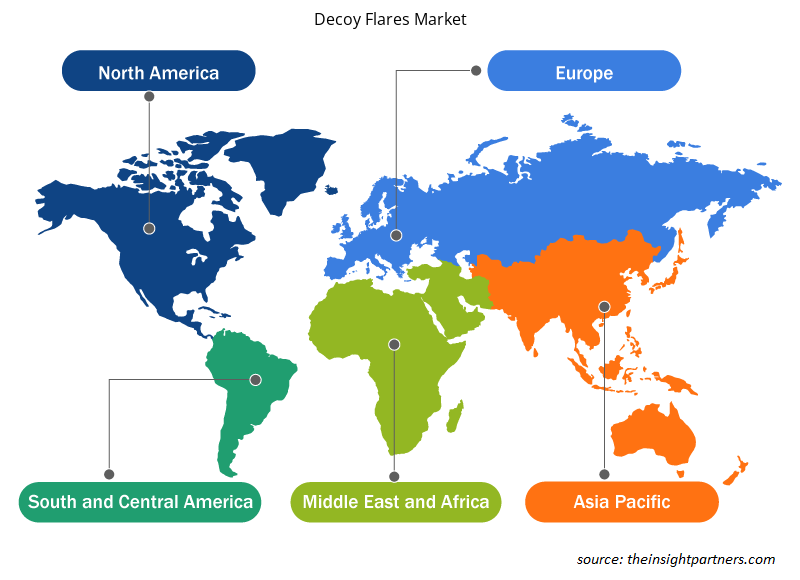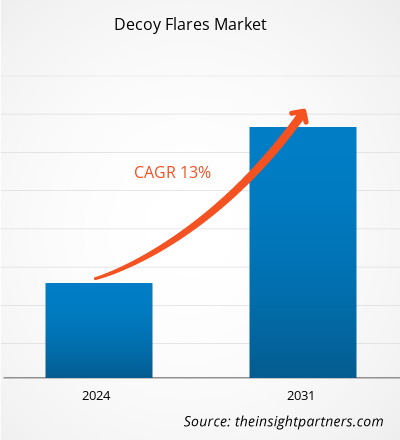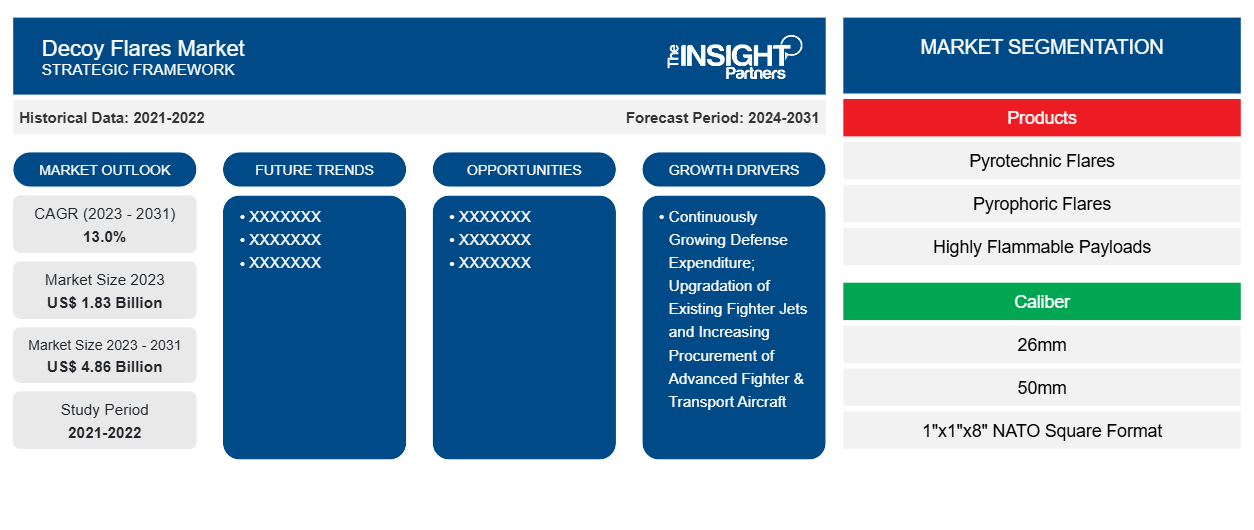Si prevede che la dimensione del mercato dei Decoy Flares raggiungerà i 4,86 miliardi di dollari entro il 2031, rispetto agli 1,83 miliardi di dollari del 2023. Si prevede che il mercato registrerà un CAGR del 13,0% nel 2023-2031. L'introduzione di decoy flare intelligenti e decoy di disturbo missilistico è una delle principali tendenze che probabilmente guideranno il mercato dei decoy flare nei prossimi anni. Diversi paesi li hanno integrati nelle rispettive forze armate per far progredire i loro armamenti.
Analisi di mercato dei razzi esca
I razzi di segnalazione NATO in formato quadrato da 1x1x8 pollici sono tra i calibri di razzi di segnalazione più ampiamente accettati. Ciò è dovuto alla versatilità del calibro di integrarsi su vari modelli di aeromobili. I produttori di aeromobili nordamericani ed europei (tranne la Russia) preferiscono fortemente integrare razzi di segnalazione NATO in formato quadrato da 1x1x8 pollici. Alcuni dei modelli di aeromobili in grado di trasportare razzi di segnalazione NATO in formato quadrato da 1x1x8 pollici includono: Apache AH-64, F-16, A-10, Ch-47 Chinook, C-130 e A400M. I volumi di produzione dei modelli di aeromobili sopra menzionati continuano a crescere ogni anno, il che riflette l'aumento della domanda di razzi di segnalazione NATO in formato quadrato da 1x1x8 pollici, che guida il mercato degli razzi di segnalazione.
Panoramica del mercato dei razzi esca
Gli stakeholder principali nel mercato dei razzi esca sono i fornitori di materie prime, i produttori di razzi esca e gli utenti finali. I produttori di razzi esca si procurano costantemente materie prime dai fornitori per produrre volumi maggiori di razzi esca con l'obiettivo di soddisfare le richieste dei clienti. Le materie prime utilizzate nella produzione di razzi esca includono sostanze chimiche energetiche (componenti pirotecnici) e gusci. La disponibilità di un gran numero di fornitori di materie prime consente agli operatori del mercato dei razzi esca di scegliere il fornitore appropriato. Ciò migliora la catena di fornitura del mercato dei razzi esca. Dopo essersi procurati le materie prime, gli operatori del mercato dei razzi esca producono volumi significativi di razzi esca con calibri diversi, soddisfacendo così le rispettive richieste dei clienti. Gli utenti finali nel mercato dei razzi esca includono produttori di aeromobili/elicotteri e le forze di difesa. Questi utenti finali richiedono volumi significativi di razzi esca per integrarli nei modelli di aeromobili più recenti e nelle flotte esistenti.
Personalizza questo report in base alle tue esigenze
Riceverai la personalizzazione gratuita di qualsiasi report, comprese parti di questo report, o analisi a livello nazionale, pacchetto dati Excel, oltre a usufruire di grandi offerte e sconti per start-up e università
-
Scopri le principali tendenze di mercato in questo rapporto.Questo campione GRATUITO includerà analisi di dati che spaziano dalle tendenze di mercato alle stime e alle previsioni.
Driver e opportunità del mercato dei flare esca
Aumento degli acquisti di aerei da combattimento ed elicotteri
L'aumento degli acquisti di aerei da combattimento militari ed elicotteri da combattimento in tutto il mondo è uno dei principali fattori che determinano l'installazione di razzi esca in diverse regioni. Ad esempio, nell'aprile 2023, il Dipartimento della Difesa degli Stati Uniti ha assegnato un contratto del valore di 7,8 miliardi di dollari alla Lockheed Martin Corporation per la modifica di 126 unità di velivoli multiruolo F-35. Analogamente, nel dicembre 2023, la Bundeswehr tedesca e Airbus Helicopters hanno firmato un contratto per l'acquisto di un massimo di 82 elicotteri multiruolo H145M (62 ordini fermi più 20 opzioni). Inoltre, nel giugno 2022, la Spagna ha ordinato 20 jet Eurofighter da Airbus nell'ambito di un contratto storico per modernizzare la sua flotta di aerei da combattimento. Tali contratti hanno spinto l'impiego di razzi esca nelle piattaforme di aerei ed elicotteri militari .DoD awarded a contract worth US$ 7.8 billion to Lockheed Martin Corporation for the modification of 126 units of F-35 multi-role aircraft. Similarly, in December 2023, the German Bundeswehr and Airbus Helicopters signed a contract for the purchase of up to 82 multi-role H145M helicopters (62 firm orders plus 20 options). Additionally, in June 2022, Spain ordered 20 Eurofighter jets from Airbus under landmark contract to modernise its combat aircraft fleet. Such contracts have been pushing the deployment of decoy flares into the military aircraft and
L'impiego di droni da combattimento guiderà la crescita del mercato nei prossimi anniUAVs to Drive the Market Growth in The Coming Years
L'aumento degli acquisti di droni militari per operazioni ISR e di combattimento è un altro fattore importante che probabilmente genererà nuove opportunità per i venditori del mercato dei flare esca nei prossimi anni. Diversi paesi hanno iniziato a schierare droni da combattimento nelle rispettive flotte militari per migliorare le loro capacità di guerra, il che sta guidando il mercato per diversi tipi di armi e sistemi di contromisure. Inoltre, secondo diverse fonti del settore della difesa, la Russia ha recentemente (nel 2024) schierato missili basati su flare esca nel territorio ucraino per superare i radar ucraini. Tali applicazioni emergenti probabilmente genereranno nuove opportunità per i venditori del mercato durante il periodo di previsione.ISR & combat operations is another major factor likely to generate new opportunities for decoy flare market vendors in the coming years. Several countries have started deploying combat drones into their respective military fleets to advance their warfare capabilities which is driving the market for different types of weapons and countermeasure systems as well. Further, as per several defense sector sources, Russia recently (in 2024) have deployed decoy flares-based missile into Ukraine’s territory to surpass the Ukrainian radars. Such emerging applications are likely to generate new opportunities for market vendors during the forecast period.
Analisi della segmentazione del rapporto di mercato dei razzi esca
I segmenti chiave che hanno contribuito alla derivazione dell'analisi di mercato dei razzi esca sono prodotti, calibro, applicazione e geografia.
- In base ai prodotti, il mercato Decoy Flares è stato suddiviso in razzi pirotecnici, razzi piroforici e carichi utili altamente infiammabili. Il segmento dei carichi utili altamente infiammabili ha detenuto una quota di mercato maggiore nel 2023.
- In base al calibro, il mercato Decoy Flares è stato segmentato in 26 mm, 50 mm, 1”x1”x8” NATO formato quadrato, 2”x1”x8” NATO formato quadrato. Il segmento 1”x1”x8” NATO formato quadrato ha detenuto la quota maggiore del mercato nel 2023.
- In base all'applicazione, il mercato dei Decoy Flares è stato diviso in ala fissa e ala rotante. Il segmento ad ala fissa ha detenuto una quota di mercato maggiore nel 2023.
Analisi della quota di mercato dei razzi esca per area geografica
L'ambito geografico del rapporto sul mercato dei razzi di segnalazione è suddiviso principalmente in cinque regioni: Nord America, Europa, Asia Pacifico, Medio Oriente e Africa e Sud America.
Il Nord America ha dominato il mercato dei razzi esca nel 2023, mentre la regione Asia-Pacifico probabilmente assisterà a una crescita significativa durante il periodo di previsione. Geograficamente, il Nord America è il principale investitore nel mercato dei razzi esca, a causa della presenza di un gran numero di OEM di aeromobili militari nella regione. I giocatori includono aziende come Lockheed Martin Corporation, Boeing, General Dynamics e Airbus. Inoltre, la domanda di razzi esca in Nord America è anche guidata dalla presenza degli Stati Uniti, che sono il paese con la maggiore spesa militare al mondo e hanno la più grande flotta di aerei ed elicotteri militari rispetto a qualsiasi altro paese a livello globale. Tali fattori hanno guidato la crescita del mercato dei razzi esca nella regione del Nord America.
Approfondimenti regionali sul mercato dei razzi esca
Le tendenze regionali e i fattori che influenzano il mercato Decoy Flares durante il periodo di previsione sono stati ampiamente spiegati dagli analisti di Insight Partners. Questa sezione discute anche i segmenti e la geografia del mercato Decoy Flares in Nord America, Europa, Asia Pacifico, Medio Oriente e Africa e America meridionale e centrale.

- Ottieni i dati specifici regionali per il mercato dei razzi esca
Ambito del rapporto di mercato sui razzi esca
| Attributo del report | Dettagli |
|---|---|
| Dimensioni del mercato nel 2023 | 1,83 miliardi di dollari USA |
| Dimensioni del mercato entro il 2031 | 4,86 miliardi di dollari USA |
| CAGR globale (2023-2031) | 13,0% |
| Dati storici | 2021-2022 |
| Periodo di previsione | 2024-2031 |
| Segmenti coperti |
Per prodotti
|
| Regioni e Paesi coperti |
America del Nord
|
| Leader di mercato e profili aziendali chiave |
|
Densità degli attori del mercato: comprendere il suo impatto sulle dinamiche aziendali
Il mercato Decoy Flares Market sta crescendo rapidamente, spinto dalla crescente domanda degli utenti finali dovuta a fattori quali l'evoluzione delle preferenze dei consumatori, i progressi tecnologici e una maggiore consapevolezza dei vantaggi del prodotto. Con l'aumento della domanda, le aziende stanno ampliando le loro offerte, innovando per soddisfare le esigenze dei consumatori e capitalizzando sulle tendenze emergenti, il che alimenta ulteriormente la crescita del mercato.
La densità degli operatori di mercato si riferisce alla distribuzione di aziende o società che operano in un particolare mercato o settore. Indica quanti concorrenti (operatori di mercato) sono presenti in un dato spazio di mercato in relazione alle sue dimensioni o al valore di mercato totale.
Le principali aziende che operano nel mercato dei razzi esplosivi sono:
- Tecnologie di difesa Armtec
- Gruppo Chemring PLC
- Pubblicità aerospaziale TARA
- Gruppo TransDigm Incorporato
- Azienda
- LACROIX
Disclaimer : le aziende elencate sopra non sono classificate secondo un ordine particolare.

- Ottieni una panoramica dei principali attori del mercato Decoy Flares
Notizie di mercato e sviluppi recenti sui razzi esca
Il mercato dei Decoy Flares viene valutato raccogliendo dati qualitativi e quantitativi dopo la ricerca primaria e secondaria, che include importanti pubblicazioni aziendali, dati associativi e database. Di seguito è riportato un elenco degli sviluppi nel mercato dei decoy flares e delle strategie:
- Nel gennaio 2024, Rheinmetall si è aggiudicata un contratto (2024-2029) del valore di 54,4 milioni di dollari USA per la fornitura di razzi di segnalazione per aerei alle forze armate tedesche, in base al quale Rheinmetall fornirà 470.000 razzi di segnalazione alle forze di Berlino. (Fonte: Rheinmetall, comunicato stampa/sito Web aziendale/newsletter)
- Nell'ottobre 2021, Chemring Australia ha ricevuto una modifica del contratto da 18,69 milioni di dollari USA (di cui 2,67 milioni di dollari USA in fondi FMS) dal Naval Air Systems Command per produrre e consegnare 9.728 contromisure a raggi infrarossi MJU-68/B: 7.256 per la Marina degli Stati Uniti e 1.152 per l'Aeronautica militare degli Stati Uniti; 528 per la Norvegia; 336 per il Giappone; 312 per i Paesi Bassi e 144 per l'Italia. (Fonte: Chemring Group, comunicato stampa/sito Web aziendale/newsletter)
Copertura e risultati del rapporto di mercato sui razzi esca
Il rapporto "Dimensioni e previsioni del mercato dei razzi esca (2021-2031)" fornisce un'analisi dettagliata del mercato che copre le seguenti aree:
- Dimensioni e previsioni del mercato a livello globale, regionale e nazionale per tutti i segmenti di mercato chiave coperti dall'ambito
- Dinamiche di mercato come fattori trainanti, vincoli e opportunità chiave
- Principali tendenze future
- Analisi dettagliata delle cinque forze di Porter
- Analisi di mercato globale e regionale che copre le principali tendenze di mercato, i principali attori, le normative e gli sviluppi recenti del mercato
- Analisi del panorama industriale e della concorrenza che copre la concentrazione del mercato, l'analisi della mappa di calore, i principali attori e gli sviluppi recenti
- Profili aziendali dettagliati con analisi SWOT
- Analisi storica (2 anni), anno base, previsione (7 anni) con CAGR
- Analisi PEST e SWOT
- Valore/volume delle dimensioni del mercato - Globale, Regionale, Nazionale
- Industria e panorama competitivo
- Set di dati Excel
Report recenti
Testimonianze
Motivo dell'acquisto
- Processo decisionale informato
- Comprensione delle dinamiche di mercato
- Analisi competitiva
- Analisi dei clienti
- Previsioni di mercato
- Mitigazione del rischio
- Pianificazione strategica
- Giustificazione degli investimenti
- Identificazione dei mercati emergenti
- Miglioramento delle strategie di marketing
- Aumento dell'efficienza operativa
- Allineamento alle tendenze normative























 Ottieni un campione gratuito per - Mercato dei razzi esca
Ottieni un campione gratuito per - Mercato dei razzi esca